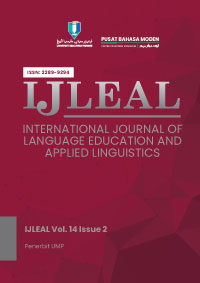Investigation of the Malaysian Chinese’s Knowledge Level on Malay Classifier Biji: Comparative Evidence from the East Coast and Central Coast
DOI:
https://doi.org/10.15282/ijleal.v14i2.10711Keywords:
Chinese East Coast and Central Coast; knowledge level; Malay classifier; biji; comparativeAbstract
Classifiers play a vital role in Malaysian daily interactions, reflecting the country's diverse ethnicities, cultures, and languages. Despite past studies indicating a decline in classifier usage among the younger generation, Malaysian Chinese individuals generally exhibit unsatisfactory proficiency in the Malay classifier. However, there is a belief that the heightened exposure of Chinese individuals in Malaysia's East Coast may contribute to a more nuanced understanding of Malay language and culture. This study compares the proficiency of Malaysian Chinese individuals from the East Coast and Central Coast in mastering the Malay classifier biji. Additionally, the study aims to elucidate the collocation of biji with nouns that are foreign, infrequently used, and unfamiliar to Chinese individuals in Malaysia. A 50-question questionnaire distributed via WhatsApp was utilised, recruiting 100 Mandarin-speaking participants from each region. The questions were formulated based on definitions and examples from authoritative Malay classifier dictionaries. Statistical analyses were conducted using data generated from Google Forms. Results reveal that geographic location does not significantly affect the understanding of the Malay classifier biji among East Coast residents, with overall performance below 50% in both regions. Respondents from both regions demonstrate better comprehension of typical biji characteristics but struggle with atypical applications, particularly concerning long fruits and vegetables, as well as kitchen utensils or containers with oblate, hollow, and slender attributes. Key influential factors include native language, language usage frequency, unfamiliarity with Malay culture, and school curricula. The findings aim to provide guidelines for second language learning and pedagogy, curriculum syllabi design, and to deepen insights into Malaysia's sociolinguistic landscape, thereby facilitating the development of targeted strategies to address linguistic challenges.
Downloads
Published
Issue
Section
License
Copyright (c) 2024 The Author(s)

This work is licensed under a Creative Commons Attribution-NonCommercial 4.0 International License.




